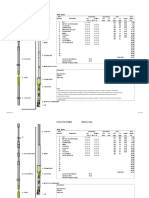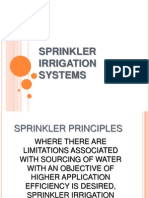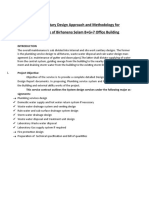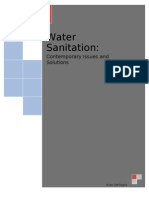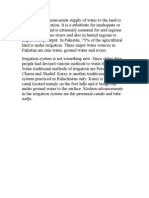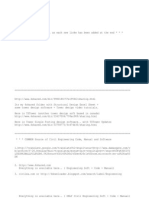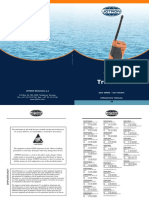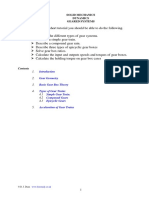Irrigation Tutorials
Irrigation Tutorials
Uploaded by
Pratik SolankiCopyright:
Available Formats
Irrigation Tutorials
Irrigation Tutorials
Uploaded by
Pratik SolankiOriginal Description:
Copyright
Available Formats
Share this document
Did you find this document useful?
Is this content inappropriate?
Copyright:
Available Formats
Irrigation Tutorials
Irrigation Tutorials
Uploaded by
Pratik SolankiCopyright:
Available Formats
B E SEMESTER-VII (CIVIL) SUBJECT: IRRIGATION ENGINEERING ASSIGNMENTS TUTORIAL:1 1. Define irrigation. What is the necessity of irrigation? 2.
Explain benefits and ill effects of irrigation. 3. What are the different forms of soil-water? Explain Field capacity, Permanent wilting point and Readily available moisture. 4. Describe with the help of sketch various forms of soil moisture. 5. Calculate the depth of available soil moisture in the root zone of the clay-loam type of soil using following data: a. Field capacity = 27% b. Permanent wilting point = 13% c. Dry density of soil = 1.5 g/cm3 d. Root zone depth = 1.25m 6. Explain crop rotation, Root-zone depth, Kor period and Kor watering, Wilting co-efficient and field capacity. 7. Define: GCA, CCA, Intensity of irrigation, Duty and Delta. 8. Explain various factors affecting Duty. 9. How duty can be improved? 10. What do you understand by consumptive use of water? How it is different from evapotranspiration. 11. What are the factors affecting irrigation water requirement of a crop? 12. Explain various irrigation efficiencies. 13. Discuss various methods of assessment of irrigation water. 14. An irrigation channel runs for 125 days in a season when wheat is grown, total depth of water is found to be 38cm. Find the duty of irrigation channel water. 15. For a distributor the GCA is 500 Ha., CCA is 80% of GCA, the intensity of irrigation is 30% for wheat and 12% for rice. If the kor period is 3 weeks for the former and 2weeks for the latter, neglecting the losses, determine the outlet discharge. Assume suitable depths for kor watering. 16. What are principal rabi & kharif crops of India? Mention their time of sowing, harvesting, water requirement & number of watering required in general. 17. A main canal, which off takes from a storage reservoir, has to irrigate crops in a certain country having three seasons in a year. Duty at the head Crop period in Area to be Sr No Name of Crop of the main canal days irrigated in Ha in Ha/cumec 1 (a) Sugarcane 280 315 630 Overlap for sugarcane in (b) 100 70 630 hot weather
2 3 4
Jowar(Rabi) Bajri (Monsoon) Vegetables (Hot season)
120 120 120
4800 5600 350
1600 2800 700
a. Find the discharge required at the head of the main canal, taking time factor for the main canal as 0.7 b. What should be the gross storage capacity of the reservoir? Assume suitable factors, whenever needed.
TUTORIAL-2 (MODULE-2) 1. 2. 3. 4. 5. 6. 7. 8. 9. 10. 11. Explain the classification of irrigation canals. What are the factors that effect the alignment of a canal? Explain watershed canals and contour canals. Explain water losses in canals. Explain Kennedys theory for the design of irrigation channel in alluvial soil. Give drawbacks of Kennedys theory. Explain Laceys Regime theory. Explain advantages and disadvantages of lining of canals. What do you understand by water logging? What are the main causes of water logging? Explain different lay outs of tile drains with sketches. Design an irrigation channel to carry a discharge of 5cumec. Assume N = 0.0225 and m = 1. The channel has a bed slope of 1 in 5000. 12. Design a channel for 28 cumec discharge having B / D = 7.6 and N = 0.0225. Assume m = 1. 13. Design a regime channel for a discharge of 50 cumecs and silt factor 1.1, using Laceys theory. 14. Draw typical cross section of an irrigation canal and explain various terms related to it.
Module III DIVERSION HEAD WORKS
1. What is canal headwork? Describe functions of canal headworks. Draw its layout. 2. Draw neat sketch of canal head regulators. Write down its functions. 3. What are the limitations of blighs theory? 4. Explain khoslas method of independent variable & their corrections 5. Fig. shows a hydraulic structure built up on fine sand ( c = 15). Determine a) Whether the percolation gradient is safe. b) Uplift pressure at point A, B & C at distance 15, 25, 35 m from u/s end/ c) Thickness of the floor at these points Use Blighs theory. Take G = 2.2
4m A 6m B C
15 m
10 m 35 m
10 m
8m
6. Determine the uplift pressure at the salient points E1, D1 & C1 of the u/s pile shown in the fig.
4m
E1 5m
C1
D1
35 m
7. Determine the uplift pressure at the salient points E, D & C of the d/s pile shown in fig. Also determine the exit gradient.
4m
C 5m
40 m
Module IV CROSS DRAINAGE WORKS
1. Describe the various types of CD works on canal with the help of neat sketch. In which condition, each type is moat suitable. 2. Discuss the effect of the change of the alignment of the canal on the type of CD works? 3. What factors will you consider while selecting a suitable site of CD works? 4. What is transition? What is its purpose? 5. Explain the method of determining uplift pressure on barrel roof of siphon aqueduct.
CANAL REGULATION WORKS
1. What is canal fall? Discuss each type of fall with a neat sketch. 2. What are the factors governing alignment of the off taking canals? Discuss various types of alignment. 3. Explain the functions of the distributory head regulator & cross regulator. 4. What is an escape? What are different types of escapes? Draw neat sketch of each type.
You might also like
- BHA Drawing SpreadsheetDocument14 pagesBHA Drawing SpreadsheetDevon75% (4)
- Sprinkler Irrigation SystemsDocument80 pagesSprinkler Irrigation SystemsMonde NuylanNo ratings yet
- BoqDocument12 pagesBoqpavlovicrs100% (1)
- Shortcut Nitrogen Removal-Nitrite Shunt and DeammonificationFrom EverandShortcut Nitrogen Removal-Nitrite Shunt and DeammonificationNo ratings yet
- Foundation Consultants LTD.: M/S Kakoli Dying and Printing Works Ltd. Report OnDocument53 pagesFoundation Consultants LTD.: M/S Kakoli Dying and Printing Works Ltd. Report Onপ্রিয়দীপ প্রিয়মNo ratings yet
- Geotechnical Assessment of Dam SiteDocument16 pagesGeotechnical Assessment of Dam SiteFaroq MaraqaNo ratings yet
- Level 1. EngineerDocument5 pagesLevel 1. EngineerDaniel mekete100% (1)
- Desalination BOQDocument7 pagesDesalination BOQDishantha PrasadNo ratings yet
- Sanitary Design Methodology For Birhan Ena SelamDocument4 pagesSanitary Design Methodology For Birhan Ena SelamMiku100% (1)
- Karamoja Productive Asset Program Small Earth Dam Technical Assessment Report 09.2010Document29 pagesKaramoja Productive Asset Program Small Earth Dam Technical Assessment Report 09.2010Gezim Bytyqi100% (1)
- Drainage ManualDocument25 pagesDrainage Manualgertjani100% (1)
- Water Sanitation:: Contemporary Issues and SolutionsDocument69 pagesWater Sanitation:: Contemporary Issues and SolutionswatercenterNo ratings yet
- Biological Phosphorus and Nitrogen Removal From WastewaterDocument9 pagesBiological Phosphorus and Nitrogen Removal From WastewaterManuel AlejandroNo ratings yet
- Water Management ChecklistDocument5 pagesWater Management ChecklistRam P MonyNo ratings yet
- STD-SPE-G-012 WSA 03 Water Supply Code SupplementDocument36 pagesSTD-SPE-G-012 WSA 03 Water Supply Code Supplementhung0% (1)
- Methodology and ScheduleDocument3 pagesMethodology and ScheduleAmith Unnimadhavan UNo ratings yet
- Lecture 7 - Well Drilling and DesignDocument61 pagesLecture 7 - Well Drilling and Designcrainvictor 45No ratings yet
- Water Treatment Plant Design Specifications Checklist: A. Provincial/City/Municipality ProfileDocument2 pagesWater Treatment Plant Design Specifications Checklist: A. Provincial/City/Municipality ProfileNiwled UyNo ratings yet
- 14 - Structural DrawingsDocument22 pages14 - Structural DrawingsLeroy Tuscano100% (1)
- Conclusion of ProjectDocument1 pageConclusion of ProjectAtiqur RahmanNo ratings yet
- GIS Based Analysis of Shoreline Change in Ibeno, Akwa Ibom State, NigeriaDocument14 pagesGIS Based Analysis of Shoreline Change in Ibeno, Akwa Ibom State, NigeriaRestoration2010No ratings yet
- Stormwater Report-Compiled 150217Document103 pagesStormwater Report-Compiled 150217realhartfordNo ratings yet
- WEP For Gypsum Board False CeilingDocument6 pagesWEP For Gypsum Board False Ceilingpalash100% (1)
- Capital Gate Tower Construction ManagementDocument2 pagesCapital Gate Tower Construction ManagementHasitha Sri CharindaNo ratings yet
- 323 2-79seDocument42 pages323 2-79seAnonymous ELujOV3No ratings yet
- TDs - Emaco R101Document3 pagesTDs - Emaco R101Venkata RaoNo ratings yet
- Literature Review On Physicochemical Analysis of WaterDocument7 pagesLiterature Review On Physicochemical Analysis of WaterafmzsawcpkjfzjNo ratings yet
- Erosion and Sedimentation Analysis of Rural Channels (RC) and Main Drainage Channels (MDC) On Tidal Lowland in IndonesiaDocument8 pagesErosion and Sedimentation Analysis of Rural Channels (RC) and Main Drainage Channels (MDC) On Tidal Lowland in IndonesiaInternational Journal of Innovative Science and Research TechnologyNo ratings yet
- The WBSDocument3 pagesThe WBSVasile Paul Pop0% (4)
- Session 03-Uom 2019 - Iesl Code of Ethics-ADocument39 pagesSession 03-Uom 2019 - Iesl Code of Ethics-AAsitha RathnayakeNo ratings yet
- Technical SpecificayionDocument40 pagesTechnical SpecificayionDebjit KunduNo ratings yet
- Comparisons Between FIDIC 1999 and Ethiopian PPA 2011 Conditions of Contract in Terms of TimeDocument10 pagesComparisons Between FIDIC 1999 and Ethiopian PPA 2011 Conditions of Contract in Terms of TimeMohammed AdaneNo ratings yet
- Geotechnical Lab Technician Resume Exam... Gineers IncDocument5 pagesGeotechnical Lab Technician Resume Exam... Gineers IncshafiullahNo ratings yet
- Pipe Network: Types of Pipe Networks 1. Dead-End SystemDocument4 pagesPipe Network: Types of Pipe Networks 1. Dead-End SystemKryzzane Jen Sapla TañadaNo ratings yet
- 5 Construction Method Statement: 5.1 General DescriptionDocument12 pages5 Construction Method Statement: 5.1 General DescriptionUpali Karunarathne100% (1)
- SBA2021 04 Elevated Water Storage Tower Project COMPLETE REPORTDocument171 pagesSBA2021 04 Elevated Water Storage Tower Project COMPLETE REPORTsamkelo shongweNo ratings yet
- Bid Bulletin No 6 - MTCL PACKAGE 4 BOSO-BOSO PUMPING STATION AND RESERVOIRDocument7 pagesBid Bulletin No 6 - MTCL PACKAGE 4 BOSO-BOSO PUMPING STATION AND RESERVOIRFrancis Nano FerrerNo ratings yet
- Borehole Siting Document PDFDocument17 pagesBorehole Siting Document PDFGoodson ChitsaNo ratings yet
- Lec16 Drainage Design Hoogout MethodDocument41 pagesLec16 Drainage Design Hoogout MethodMuhammad AliNo ratings yet
- Drainage Design HAND NoteDocument18 pagesDrainage Design HAND NoteShoayful islamNo ratings yet
- Septic Tank Installation - Regular SoilDocument2 pagesSeptic Tank Installation - Regular SoilKelly MartinNo ratings yet
- SleeveDocument16 pagesSleeveengsamerhozinNo ratings yet
- Test Booklet: Irrigation EngineeringDocument3 pagesTest Booklet: Irrigation EngineeringICE Group of Education BhopalNo ratings yet
- MCCL Qaqc Sop 02 CrossingsDocument21 pagesMCCL Qaqc Sop 02 CrossingsArfanAliNo ratings yet
- Irrigation SystemDocument6 pagesIrrigation SystemJaved Iqbal25% (4)
- BFC21103 Project SemII 20152016Document9 pagesBFC21103 Project SemII 20152016Victoria JungNo ratings yet
- Chapt14 - On Site SanitationDocument20 pagesChapt14 - On Site SanitationRyeanKRumano100% (1)
- Terms of Reference (TOR) - Water Treatement PlantDocument11 pagesTerms of Reference (TOR) - Water Treatement PlantLasith Randika De zoysaNo ratings yet
- How To Decide Depth and Spacing of Trial PitsDocument3 pagesHow To Decide Depth and Spacing of Trial PitsPrantik Adhar SamantaNo ratings yet
- WSSI-part 2Document73 pagesWSSI-part 2Abdisa Legese100% (1)
- Estimation Quality Control of Residential G+3 BuildingDocument5 pagesEstimation Quality Control of Residential G+3 BuildingInternational Journal of Innovative Science and Research Technology100% (1)
- Pecc-J-1207 Method Statement For Cable Diversion WorksDocument6 pagesPecc-J-1207 Method Statement For Cable Diversion WorksMuneeswaran BalaguruNo ratings yet
- Trial Pit TesrDocument10 pagesTrial Pit TesrscwanhkerNo ratings yet
- Solid Waste Treatment and Disposal Technology (Landfill)Document25 pagesSolid Waste Treatment and Disposal Technology (Landfill)Arsyadiana AzmanNo ratings yet
- Close Out Report DraftDocument1 pageClose Out Report DraftTony JamesNo ratings yet
- Inspection of Canal and Distribution SystemDocument3 pagesInspection of Canal and Distribution SystemZaid HadiNo ratings yet
- Kassahun Merawi PDFDocument58 pagesKassahun Merawi PDFDawit WorkyeNo ratings yet
- Design of Sewerage Systems (Collection) : Prof GM Ochieng'Document51 pagesDesign of Sewerage Systems (Collection) : Prof GM Ochieng'Barrouz100% (1)
- Mulatu BufeboDocument95 pagesMulatu BufeboKubaNo ratings yet
- BOQ For MUD PLANTDocument23 pagesBOQ For MUD PLANTJIBEESH01No ratings yet
- Coast ScheduleDocument10 pagesCoast ScheduleIbrahim AliNo ratings yet
- Sediment Transport Analysis With HEC-RAS 2Document14 pagesSediment Transport Analysis With HEC-RAS 2Pratik SolankiNo ratings yet
- Gujarat Technological University Civil EngineeringDocument5 pagesGujarat Technological University Civil EngineeringPratik SolankiNo ratings yet
- General Concepts of Earthquake Resistance DesignDocument10 pagesGeneral Concepts of Earthquake Resistance DesignPratik SolankiNo ratings yet
- Best Civil Engineering Link in 4shared - Com For All Civil Engineer - Upto 08-10-10Document34 pagesBest Civil Engineering Link in 4shared - Com For All Civil Engineer - Upto 08-10-10Pratik SolankiNo ratings yet
- Data Collection & Sampling MethodsDocument44 pagesData Collection & Sampling MethodsPratik SolankiNo ratings yet
- Assignment IDocument2 pagesAssignment IPratik SolankiNo ratings yet
- FinalIndividualPaperNilo B50Document3 pagesFinalIndividualPaperNilo B50kyleNo ratings yet
- JPR ProposalDocument4 pagesJPR ProposalVishal Kesharwani100% (2)
- Ce Ped 2014-68-Eu CertificateDocument1 pageCe Ped 2014-68-Eu CertificateAvinish dubeyNo ratings yet
- Reported by George Angeles II Joshua Martin CuyosDocument26 pagesReported by George Angeles II Joshua Martin CuyosGeorge AngelesNo ratings yet
- Elements of Construct-1Document6 pagesElements of Construct-1osangeo76100% (3)
- Atlas Programming Guide PreliDocument181 pagesAtlas Programming Guide Prelid1140998No ratings yet
- Perpetuity Annuity 2Document50 pagesPerpetuity Annuity 2baldonangelie29No ratings yet
- HT Ancamine 2143Document6 pagesHT Ancamine 2143rosarioNo ratings yet
- SSF Hammer Set Socket Anchor Drop in Anchor PDFDocument1 pageSSF Hammer Set Socket Anchor Drop in Anchor PDFMauricio SosaNo ratings yet
- Cover TronvhfDocument2 pagesCover TronvhfHenry DengNo ratings yet
- PSB BEGUM BRIDGE-0169 JUNE 2023Document54 pagesPSB BEGUM BRIDGE-0169 JUNE 2023Ansh VermaNo ratings yet
- Public Sector To Public Services 20 Years of "Contextual" Accounting Research PDFDocument55 pagesPublic Sector To Public Services 20 Years of "Contextual" Accounting Research PDFveNo ratings yet
- CompanyprofileDocument22 pagesCompanyprofileSachin RaiNo ratings yet
- MSP Debuggers: User's GuideDocument55 pagesMSP Debuggers: User's GuideasampadehNo ratings yet
- GrenTech Express Communication System Introduction 1.0Document30 pagesGrenTech Express Communication System Introduction 1.0Son NguyenNo ratings yet
- Knowledge Management in The Automobile Industry - FinalDocument13 pagesKnowledge Management in The Automobile Industry - FinalAshrafAbdoSNo ratings yet
- Echegaray Vs Secretary of JusticeDocument12 pagesEchegaray Vs Secretary of JusticeCherry BepitelNo ratings yet
- PT1 2 JustinDocument5 pagesPT1 2 JustinAnnissa PacaldoNo ratings yet
- MarketingDocument10 pagesMarketingKaran ShoorNo ratings yet
- DS 85 Operators MTXDocument32 pagesDS 85 Operators MTXVenkatraman KrishnanNo ratings yet
- Starbucks: The Art of Endless TransformationDocument7 pagesStarbucks: The Art of Endless TransformationAmir Ur RehmanNo ratings yet
- Islamic Wealth Management PDFDocument10 pagesIslamic Wealth Management PDFislamicthinkerNo ratings yet
- Fancy - Parivahan.gov - in Fancy Faces Pdfprints printReceivePaymentPDF - XHTMLDocument1 pageFancy - Parivahan.gov - in Fancy Faces Pdfprints printReceivePaymentPDF - XHTMLTrending VideosNo ratings yet
- TE - 1 (Unit - 5)Document38 pagesTE - 1 (Unit - 5)Suhasini PranayNo ratings yet
- GearsDocument21 pagesGearsMunyahNo ratings yet
- Bamenda Partnership AgreementDocument2 pagesBamenda Partnership AgreementrollinpeguyNo ratings yet
- Equifax Breach PartIDocument4 pagesEquifax Breach PartIkesreschNo ratings yet
- Calc Scripts For Mere MortalsDocument94 pagesCalc Scripts For Mere MortalsparmitchoudhuryNo ratings yet
- OV Thermostat GuideDocument32 pagesOV Thermostat GuideSunnyRabiusSunnyNo ratings yet
